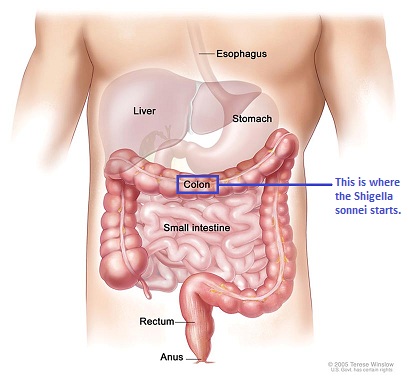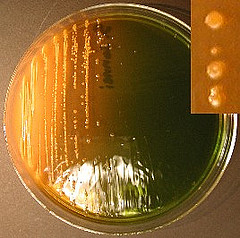Adaptation
Factors of Survival
Shigella sonnei is susceptible
to
 multiple environmental factors that do not make it possible to
live outside the human body for long. One of the environmental
factors is the dryness of the habitat. In the human intestinal tract
it is very moist, and outside a human body it is not
very successful finding such a moist place. Another environmental
factor is the
temperature that Shigella sonnei needs to survive, which is
about 37 degrees Celsius. If this
bacterial disease does not find a habitat with the proper
temperature it will die. The last major environmental factor
is the acid level or the pH of the habitat. Shigella sonnei
can survive in a pH ranging from 7 to 7.5. Any pH lower or
higher than that will cause death to the bacterial infection.
When the bacteria are excreted from the human body, it can only
survive for a mere 30 minutes in the human feces because the pH
decreases to 6.5 or 6. The human body is nearly the only
environment that can provide all the conditions that Shigella sonnei needs to survive.
multiple environmental factors that do not make it possible to
live outside the human body for long. One of the environmental
factors is the dryness of the habitat. In the human intestinal tract
it is very moist, and outside a human body it is not
very successful finding such a moist place. Another environmental
factor is the
temperature that Shigella sonnei needs to survive, which is
about 37 degrees Celsius. If this
bacterial disease does not find a habitat with the proper
temperature it will die. The last major environmental factor
is the acid level or the pH of the habitat. Shigella sonnei
can survive in a pH ranging from 7 to 7.5. Any pH lower or
higher than that will cause death to the bacterial infection.
When the bacteria are excreted from the human body, it can only
survive for a mere 30 minutes in the human feces because the pH
decreases to 6.5 or 6. The human body is nearly the only
environment that can provide all the conditions that Shigella sonnei needs to survive.

Structural Function
Shigella sonnei cannot be considered motile because it
does not have flagella, but it facilitates movement by using a
polymerizing actin. This motile movement is not recognizable to the
human body and it saves energy for the bacteria. Shigella
sonnei did develop a gene through evolution from E. coli
that makes this bacterial infection non-lactose ferment. This
bacterial infection is rod shaped which helps uptake nutrients into
the cytoplasm better than other shapes because of its
surface-to-volume ratio.
Now that you have explored why Shigella sonnei is only
viable in the human body, take a look at what it likes to consume
inside of you! GO!
